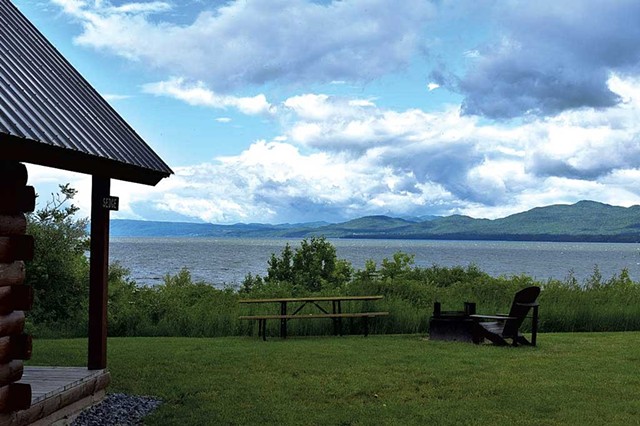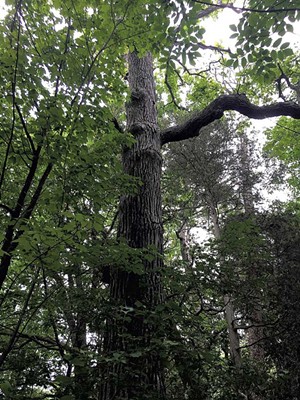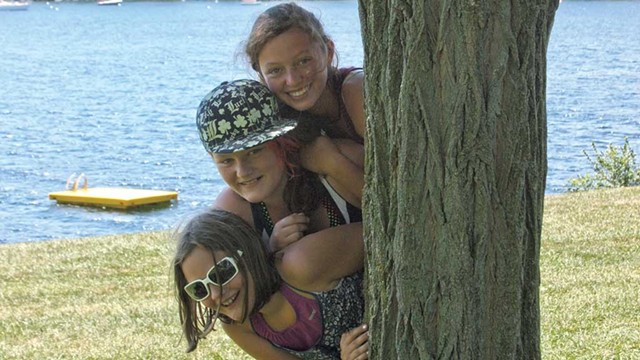Published June 29, 2021 at 10:00 a.m.
When I think of Button Bay and Kingsland Bay State Parks in Ferrisburgh, the first thing that comes to mind are the large picnics, weddings and festivals I've attended there. But, according to my copy of the Sierra Club Guide to the Ancient Forests of the Northeast, both sites also have old-growth forest. So during Vermont Days — an annual weekend in June when state park admission is free — I set out to investigate them.
Most of the old growth my guidebook highlighted at these spots consists of one of my favorite types of forest, known to ecologists as Limestone Bluff Cedar-Pine Forest. These are rare and occur only on cliffs of calcium-rich bedrock, with northern white cedar trees basically growing right out of the rock. Many years ago I read an article in Discover magazine about similar forests along some cliffs near Toronto. Botanists there were startled to discover that some of the diminutive trees growing out of the rocks had tree rings thinner than 0.1 millimeter and were up to 700 years old. The oldest dead tree they found there had been more than 1,600 years old when it died.
I'm not sure how thoroughly the cedars of Lake Champlain's bluffs have been sampled, but my guidebook mentions trees at these parks that are 300 to 500 years old. I imagine that, like in other places in Vermont, the trees that escaped cutting are hard to reach — perhaps only accessible through rock climbing. The botanists found that a tapered-growth form — wide base, thin at the top — was most predictive of great age.
These cliffs are pretty special places. In addition to the impressive age of the old-growth cedars, the Canadian botanists noted extreme conditions, including temperatures ranging as high as 110 degrees Fahrenheit and as low as -20 and plants usually found in Arctic regions.
Button Bay State Park has campgrounds, a playground, a swimming pool, a picnic area and other amenities that might be the highlight of a young child's visit. I am a veteran of many nature outings with my vehicle-obsessed son, who many years later is apt to ask about an amazing natural place we once visited: "Oh, is that the place that had those green golf carts?" I am going to remind us all that this is fine. One of our jobs is to give our kids chances to find their own moments of flow, whatever that may look like.
All we have to do is expose them to nature, model our interest — "Now it's Mom's turn, and we're going to go look for a very old forest" — and ask them, and ourselves, questions about the obvious things we see all the time and don't usually pause to think about.
For example, How can a tree grow out of rock? Answer: According to the Canadian botanists, they grow by taking advantage of tiny pockets of soil and moisture found in indentations in the rock, along with phosphorus and nitrogen collected by fungi that infiltrate the tree's roots — and perhaps even from algae that grow inside the rocks.
Why does a tree have rings, anyway? Answer: Because trees put on new growth each year. They grow fastest in the late spring and early summer, adding larger, lighter-colored cells, and slower in the late summer and fall, adding smaller, darker-colored cells.
I have to believe that these teachable moments will eventually amount to something meaningful.
The old-growth forest on Button Point has a magical feel. In addition to the cedars along the shores, there is what my guidebook calls "conventional" old-growth forest in the middle of the peninsula, with hemlocks as old as 450 years and some very large white pines (40 inches in diameter), white oaks (38 inches), red oaks (32 inches) and red pines (18 inches). You can also look for fossils and scratches in the bedrock made by glaciers.
At Kingsland Bay, my guidebook highlighted the trail just beyond Hawley House and the other facilities at the park. We walked the approximately mile-long loop, and it was lovely. But my favorite part of the park is a separate chunk of land on the other side of the bay. To get to this wilder tract, leave the park proper and turn right onto Town Beach Road. There is free parking in the town beach lot or along the road when the beach is crowded. You'll enter on a path that leads you through an old pasture with lots of scrappy red cedars growing in the field, then you'll emerge into the old-growth white cedars. The contrast helps me appreciate the wildness of the white cedar forest even more. Field naturalist Alicia Daniel's YouTube video, "Old Growth Forest at Kingsland Bay: A Tale of Two Cedars," is a nice guide to this amazing old forest; find it on the Vermont Master Naturalist channel.
When I visited these two parks, it was a hot day, and I dragged us along at a fast clip to get to all the sites I wanted to check out. We didn't even have time for swimming. If you take a trip to one of these parks, don't rush like I did! Find one or two magical places and linger there. And, as always when the temperature is above freezing, check for ticks when you get home from your adventure in the woods.
Heather Fitzgerald teaches field ecology and environmental science at the Community College of Vermont, the University of Vermont and Saint Michael's College.
This article was originally published in Seven Days' monthly parenting magazine, Kids VT.
More By This Author
Speaking of...
-

Signs of Fall: Using Free Apps and Phenology to Track the Rhythms of the Year
Aug 24, 2021 -

Trail Adventures at Colchester's Niquette Bay State Park
Jun 1, 2021 -

Exploring Frogs, Flowers and Floodplains in May
May 4, 2021 -

Experiencing Spring Through the Senses
Apr 6, 2021 -

Learning the Art of Slow Birding
Mar 2, 2021 - More »
Comments
Comments are closed.
From 2014-2020, Seven Days allowed readers to comment on all stories posted on our website. While we've appreciated the suggestions and insights, right now Seven Days is prioritizing our core mission — producing high-quality, responsible local journalism — over moderating online debates between readers.
To criticize, correct or praise our reporting, please send us a letter to the editor or send us a tip. We’ll check it out and report the results.
Online comments may return when we have better tech tools for managing them. Thanks for reading.

















































